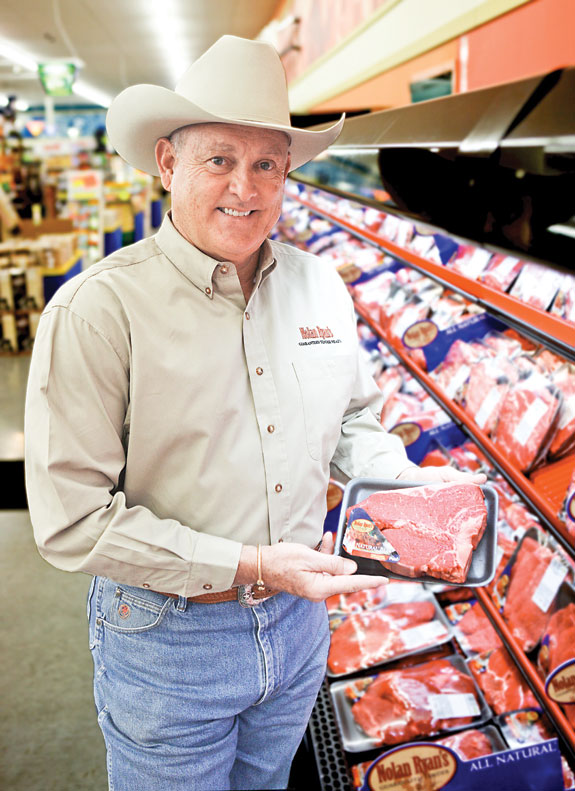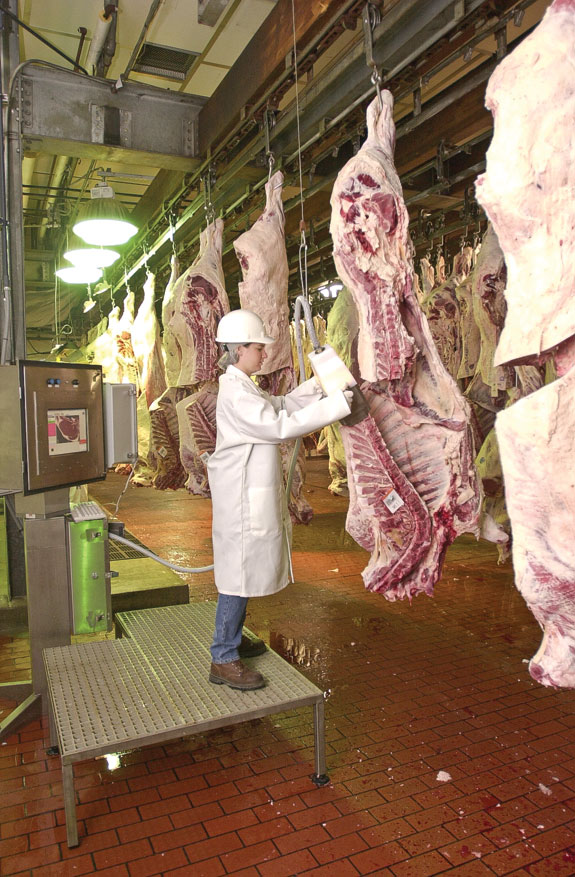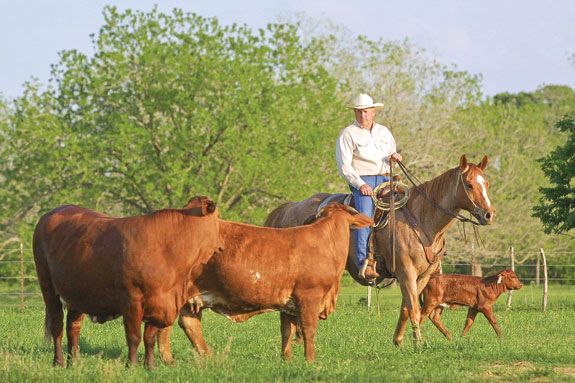Beefmaster Cattlemen introduced a product that created a niche. Their brand, Nolan Ryan’s Guaranteed Tender Beef, debuted in 2000 as a value-added select product and was designed to unite a supply of Brahman-influenced cattle with a demand for a lean and tender eating experience.
An interview with Charlie Bradbury, CEO of Beefmaster Cattlemen LP, recounts the birth and legacy of that brand.
Bradbury, as former chairman of a long-range planning committee for Beefmaster Breeders United, recognized the marketing ingenuity of Certified Angus Beef and its influence on cattlemen’s perceptions of successful genetics.

The “added value” concept from Certified Angus had propelled the market for producers buying black-hided bulls and consumers purchasing certified products.
“The only way to ensure a demand for [Beefmaster] genetics was to basically do the same thing,” noted Bradbury, “create a direct link between [the] consumers and the cattle they were producing.”
Others joined Bradbury in taking inventory of the advantages Beefmaster cattle offer to the marketplace. Brahman-influenced cattle “are lean, they yield well, and they fit in this environment,” he noted.
However, “the perception we found in the beef industry was that those cattle produce a tough product.”

Beefmaster Breeders United provided some research seed money and the company partnered with the Beef Checkoff to research tenderness correlates.
The academic community helped develop two generations of tenderness prediction technology using a camera that currently uses near-infrared and visible light spectrums to relate lean color from the ribeye to its shear force.
Several meat scientists, initially at Colorado State University and later at the USDA Meat Animal Research Laboratory at Clay Center, Nebraska, including Gary Smith and Keith Belk, and later Tommy Wheeler and Steven Shackelford, calibrated an algorithm for the prediction of tenderness by reflective color measurement.
The team of scientists and entrepreneurs determined a set of specifications that would eliminate bad eating experiences. Many beef consumers generally assume marbling and tenderness go hand-in-hand, or that lean and tender are mutually exclusive qualities.
“What we learned was that the two were not really related … at least not in the population of cattle we are working with,” observed Bradbury. These efforts resulted in the premier of the select product, Guaranteed Tender.
Bradbury and several partners formed a company called Beefmaster Cattlemen. They approached baseball Hall-of-Famer Nolan Ryan, who at the time presided over Beefmaster Breeders United.

Ryan enthusiastically accepted the offer to brand their product with his name. The face of a trusted Texas icon offered the right allure to a new product.
Featuring him, they decided, would help people approach their product at the meat counter for the first time. The strict disciplines of quality production would help keep people coming back.
Though their beef products submit to strict protocols, cow-calf operators are fully autonomous in their genetic management.
Beefmaster Cattlemen do not buy cattle; the financial involvement occurs only after certification at the packing plant. Only 30 percent of cattle that enter one of their four South Texas feedyards receive the stamp of “T” that guarantees tenderness.
Carcasses must weigh between 550 and 899 pounds and score yield grades of 1 or 2. Ribeye areas must span between 11 and 16.5 sq. in., with a half-inch tolerance on either side.
The cattle enter most typically as calves in following the south Texas model on limited forage resources, but yearlings are also accepted.
Cattle feed for 180 to 200 days until they reach a market weight of 1,250 to 1,350 pounds. Half of Nolan Ryan’s Guaranteed Tender Beef calves grade choice while 45 percent grade select.
Implants and antibiotics are withdrawn by 100 days until slaughter. Their feeders will also include a high level of Vitamin E in their diet, which benefits not only the animals but the product color.
“The whole thing we’re doing here is managing stress. Stress causes bad product,” Bradbury advised. Once harvested, processors tenderize carcasses with high-voltage electrical stimulation, as is common in most packing houses, and beef products are wet-aged for 14 days before being released for retail sales.
Nolan Ryan’s Beef products deck the meat counters of Kroger, Super S Stores and Sun Harvest Farmer’s Markets, and garnish the menus of Black Eyed Pea, Chapps Hamburger Café, Hooters, Texas Burger, Novrozsky’s and several venues at Rangers Ballpark in Arlington.
The food service business comprises the brand’s fastest-growing sector.
After evaluating the potential for losing market share to Whole Foods in 2007, Kroger asked Beefmaster Cattlemen to change their product line to one guaranteed completely free of antibiotic and hormone use – within a few months’ time.
Bradbury acted fast to access an existing supply of such a product, which was promptly branded Nolan Ryan’s Premium Reserve Beef and supplied to Kroger’s newly installed “never-ever” program.
“The Kroger deal looked like a horrible disaster at the time it occurred, but since then it’s really proven to be a good thing for us because it caused us to diversify,” Bradbury observed.
Two programs currently operate under Beefmaster Cattlemen: Nolan Ryan’s Guaranteed Tender Beef, which harvests 1,200 head a week, and Nolan Ryan’s Premium Reserve Beef, which harvests 250 head a week.
The company buys beef from two packers: Sam Kane in Texas and National Beef in Kansas, who handles the Premium Reserve production.
National Beef processes mostly Angus-influenced cattle that enter as yearlings and are fed for less time than the calves in the Guaranteed Tender program. All products from this line are source-verified and carry affidavits on how cattle were fed and managed.
For those looking to supply to Beefmaster Cattlemen, Bradbury advises opting for retained ownership.
“A Brahman-influence feeder calf sold at the auction barn may receive a discount, but if he’s sold as a fat steer at the packing plant, he’ll get the same price as the one that didn’t get discounted at the sale barn.”
Charlie Bradbury is confident in the consumer base the company has developed. “We are very unique. We branded a select product.
His business concerns lie with securing a supply, not the demand. “Demand’s great. We’re selling something a lot of people want to buy. We just need to figure out how to keep it produced.”
Beefmaster Cattlemen garnered their challenges into growing points for the company and its market. The company and its leaders commit to precision and excellence in the marketplace.
In response to the production obstacles put forth by the past decade, Bradbury concludes, “It’s really just focusing on a good product with a disciplined approach. Instead of chasing after one fad or another, [we’re] just trying to do the same thing very well.” ![]()
PHOTOS:
TOP: All products in the Nolan Ryan Beef line are source-verified and carry affidavits on how cattle were fed and managed.
MIDDLE: Nolan Ryan beef packers work a camera using near-infrared and visible light spectrums to relate lean color from the ribeye to its shear force.
BOTTOM: While presiding over Beefmaster Breeders United, baseball legend Nolan Ryan was approached by Beefmaster Cattlemen to brand their product with his name. Photos courtesy of Nolan Ryan’s All-Natural Beef.







